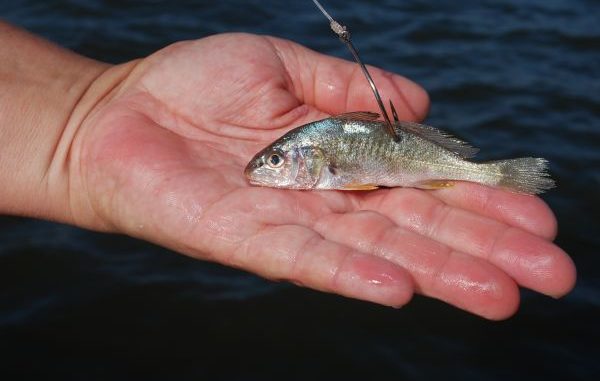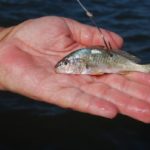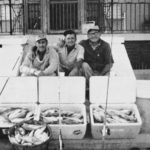
Bull croakers were once easy to find
The story of the Atlantic croaker is the story of a fish that has somehow never managed to fulfill its predicted potential. They are truly one of the most abundant fish in the sea.
Croakers are lumped together with about 200 other bottom-loving species into a group commonly tagged as groundfish or bottomfish. Seven species of the 200 make up about 75 percent of the total combined weight of all the species put together.
In descending order of importance, they are Atlantic croaker, spot, longspine porgy, hardhead catfish, sand seatrout, silver seatrout, and cutlassfish. Notice that croakers are the single most-common species in the whole group.
As well as being common, they can grow to respectable sizes. The IGFA world record is an 8-pound, 11-ounce fish caught in Virginia in 2007. Louisiana’s record is an even 8 pounds, and was caught by Douglas J. Bernard in 1972.
The latter date links us into the story of the croaker fishery not living up to its possibilities. In the 1960s and early 1970s, Louisiana recreational fishermen had a booming fishery offshore for large, outsized croakers, which they respectfully called “bull croakers.”
Then, poof — they disappeared, almost overnight.
Earlier than that, commercial fishermen targeted large croakers with hooks in Lake Pontchartrain. In an excerpt from the August 1946 edition of Louisiana Game, Fur and Fish, the magazine that became the Department of Wildlife and Fisheries’ Louisiana Conservationist, biologist James Nelson Gowanloch described the fishery:
“An interesting condition occurs in Lake Pontchartrain about August, September and even extending into October, when the croakers seem to school and work up the lake from east to west, finally disappearing in the neighborhood of Pass Manchac,” he wrote. “Their presence is indicated by large patches of brick dust-colored water, which the professional market fishermen claim is caused by the fish rooting up the bottom for food.”
They disappeared too.
During the same period, a substantial commercial fishery for croakers was conducted elsewhere in the Gulf for use for cat food. Since croakers were, and still are the most abundant groundfish in the Gulf of Mexico, it seemed that the stage was set for expansion of that fishery.
A major facility was purchased for just that purpose in Golden Meadow. It never opened.
During the late 1970s, the Atlantic croaker was the darling of the seafood marketing branch of the National Marine Fisheries Service out of Pascagoula, Miss. They renamed it the “golden croaker,” and went to work pushing it in Asia.
Ed Smith, their foreign marketing specialist, felt its flesh was an ideal candidate for the Japanese surimi industry’s production of kamaboko, a so-called fish sausage. It was white-fleshed and mild-tasting. Above all, the supply of croaker seemed inexhaustible.
That didn’t work out, either. It seems that there weren’t enough of the right-sized croakers around.
NMFS soon got out of the under-utilized fishery development and seafood promotion business, turning their attention to putting turtle excluder devices in shrimp trawls and bringing red snapper under proper management.
The puzzle of what caused the disappearance of bull croakers prompted both recreational fishermen and scientists to propose (without any research to back up the idea) that shrimp trawl bycatch was the culprit.
Without a doubt, a lot of small croakers came up in shrimp trawls and ended up being discarded dead. Wherever shrimp are, croakers are.
What added to this suspicion was the rapid growth in the numbers of shrimping vessels that began in the early 1970s and peaked in the late 1980s.
It seemed to make sense to a lot of recreational anglers. “I used to catch bull croakers, and now I don’t. Shrimp trawls catch small croakers before they grow up, and there are more of trawlers. So they are the problem.”
But things are never that easy.
In the 1980s things began to change in the shrimp industry. The first wave of farm-raised shrimp from Latin America hit U.S. shores in 1983. The wave turned into a tsunami of imports from Latin America and Asia. Shrimp prices plunged.
The cost of producing shrimp had been increasing without letup since the Arab oil embargo in 1973. The two trends crossed paths in the late 1980s; it cost more to produce shrimp than the species’ market worth.
The result was massive decline in the number of shrimpers — and that resulted in a lot fewer nets in the water, both inshore and offshore.
Then in 1998, with pushing by environmental interests, NMFS required the installation of bycatch reduction devices in offshore shrimp trawls. Essentially specially designed holes in the nets, BRDs were very effective at releasing strong-swimming fish like croakers.
They were so effective that, once inshore fishermen realized how well they worked, most nearshore trawlers and inshore skimmers began voluntarily using them.
As a result of these forces, we had a lot fewer boats using shrimp nets, and the shrimp nets that were left in use released a large percentage of the fish that did enter a net.
So by 2016, croakers — a fish that only rarely lives to 8 years old and spawns at 1 year old — should have come back in force as big bulls.
But they haven’t. Just as when the shrimp fishery was at its peak of croaker-killing efficiency, Louisiana fishermen now have lots and lots of small croakers and very, very few big ones.
So what’s to blame?
Scientists point out that croaker spawning success varies greatly from year to year, due to natural environmental conditions that affect newly hatched and helpless croaker larvae.
But surely such conditions existed in the 1960s, as well.
Other scientific suggestions include a lack of freshwater flow into the marshes that young croakers need to survive, diseases and pollution.
The truth is that no one knows for sure what is croaking the croakers before they can grow to bulls.
But we sure have a lot of fishbait.




